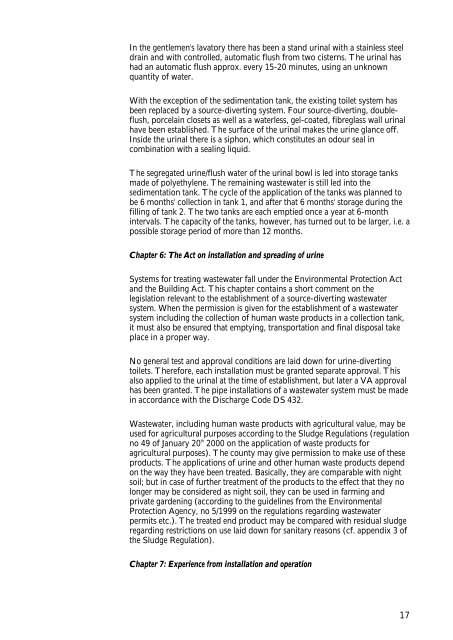Opsamling, opbevaring og udnyttelse af urin fra ... - Miljøstyrelsen
Opsamling, opbevaring og udnyttelse af urin fra ... - Miljøstyrelsen
Opsamling, opbevaring og udnyttelse af urin fra ... - Miljøstyrelsen
Create successful ePaper yourself
Turn your PDF publications into a flip-book with our unique Google optimized e-Paper software.
In the gentlemen's lavatory there has been a stand <strong>urin</strong>al with a stainless steel<br />
drain and with controlled, automatic flush from two cisterns. The <strong>urin</strong>al has<br />
had an automatic flush approx. every 15-20 minutes, using an unknown<br />
quantity of water.<br />
With the exception of the sedimentation tank, the existing toilet system has<br />
been replaced by a source-diverting system. Four source-diverting, doubleflush,<br />
porcelain closets as well as a waterless, gel-coated, fibreglass wall <strong>urin</strong>al<br />
have been established. The surface of the <strong>urin</strong>al makes the <strong>urin</strong>e glance off.<br />
Inside the <strong>urin</strong>al there is a siphon, which constitutes an odour seal in<br />
combination with a sealing liquid.<br />
The segregated <strong>urin</strong>e/flush water of the <strong>urin</strong>al bowl is led into storage tanks<br />
made of polyethylene. The remaining wastewater is still led into the<br />
sedimentation tank. The cycle of the application of the tanks was planned to<br />
be 6 months' collection in tank 1, and <strong>af</strong>ter that 6 months' storage d<strong>urin</strong>g the<br />
filling of tank 2. The two tanks are each emptied once a year at 6-month<br />
intervals. The capacity of the tanks, however, has turned out to be larger, i.e. a<br />
possible storage period of more than 12 months.<br />
Chapter 6: The Act on installation and spreading of <strong>urin</strong>e<br />
Systems for treating wastewater fall under the Environmental Protection Act<br />
and the Building Act. This chapter contains a short comment on the<br />
legislation relevant to the establishment of a source-diverting wastewater<br />
system. When the permission is given for the establishment of a wastewater<br />
system including the collection of human waste products in a collection tank,<br />
it must also be ensured that emptying, transportation and final disposal take<br />
place in a proper way.<br />
No general test and approval conditions are laid down for <strong>urin</strong>e-diverting<br />
toilets. Therefore, each installation must be granted separate approval. This<br />
also applied to the <strong>urin</strong>al at the time of establishment, but later a VA approval<br />
has been granted. The pipe installations of a wastewater system must be made<br />
in accordance with the Discharge Code DS 432.<br />
Wastewater, including human waste products with agricultural value, may be<br />
used for agricultural purposes according to the Sludge Regulations (regulation<br />
no 49 of January 20 th 2000 on the application of waste products for<br />
agricultural purposes). The county may give permission to make use of these<br />
products. The applications of <strong>urin</strong>e and other human waste products depend<br />
on the way they have been treated. Basically, they are comparable with night<br />
soil; but in case of further treatment of the products to the effect that they no<br />
longer may be considered as night soil, they can be used in farming and<br />
private gardening (according to the guidelines from the Environmental<br />
Protection Agency, no 5/1999 on the regulations regarding wastewater<br />
permits etc.). The treated end product may be compared with residual sludge<br />
regarding restrictions on use laid down for sanitary reasons (cf. appendix 3 of<br />
the Sludge Regulation).<br />
Chapter 7: Experience from installation and operation<br />
17

















